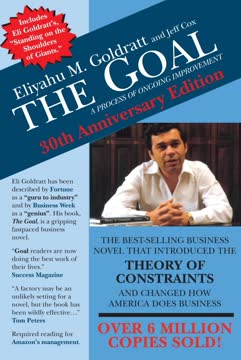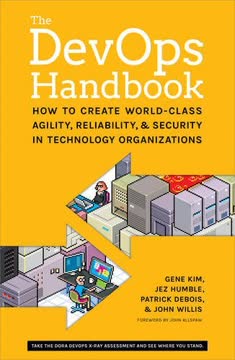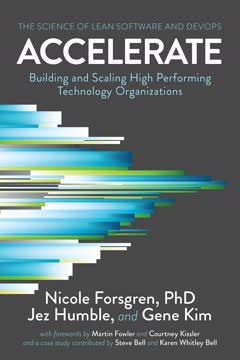Key Takeaways
1. Scrum: An Agile Framework for Complex Project Management
Scrum is the exact opposite. Unlike these tools, which practically fight against a project's natural momentum, Scrum shows management how to guide a project along its optimal course, which unfolds as the project proceeds.
Framework for complexity. Scrum is an agile project management framework designed to handle complex projects, particularly in software development. It embraces uncertainty and change, focusing on delivering value through iterative and incremental development.
Empirical process control. Scrum is based on three pillars: transparency, inspection, and adaptation. This approach allows teams to respond quickly to changes and make data-driven decisions throughout the project lifecycle.
- Key Scrum principles:
- Self-organizing teams
- Time-boxed iterations (Sprints)
- Regular delivery of potentially shippable product increments
- Continuous improvement through feedback loops
2. The Scrum Team: Roles and Responsibilities
The ScrumMaster is responsible for the Scrum process, for teaching Scrum to everyone involved in the project, for implementing Scrum so that it fits within an organization's culture and still delivers the expected benefits, and for ensuring that everyone follows Scrum rules and practices.
Three key roles. The Scrum Team consists of three primary roles: the Product Owner, the Development Team, and the ScrumMaster. Each role has specific responsibilities that contribute to the project's success.
Collaborative framework. The Scrum Team works collaboratively to achieve project goals, with each role complementing the others:
- Product Owner: Responsible for maximizing the value of the product and managing the Product Backlog
- Development Team: Self-organizing group that turns Product Backlog items into potentially shippable product increments
- ScrumMaster: Facilitates the Scrum process, removes impediments, and ensures adherence to Scrum principles
3. Sprint: The Heart of Scrum's Iterative Process
The Sprint is a time-box of 30 sequential calendar days during which a Team works to turn the Product Backlog it has selected into an increment of potentially shippable product functionality.
Time-boxed iterations. Sprints are fixed-length iterations, typically lasting 2-4 weeks, during which the Development Team works to create a potentially shippable product increment. This time-boxing creates a sense of urgency and helps maintain focus.
Sprint structure. Each Sprint follows a consistent pattern:
- Sprint Planning: Team selects Product Backlog items to work on
- Daily Scrums: 15-minute daily synchronization meetings
- Development work: Team collaborates to complete selected items
- Sprint Review: Demonstration of completed work to stakeholders
- Sprint Retrospective: Team reflection on process improvement
4. Product Backlog: Prioritizing and Managing Project Requirements
The Product Backlog is a prioritized list of project requirements with estimated times to turn them into completed product functionality.
Living artifact. The Product Backlog is a dynamic, prioritized list of all desired features, enhancements, and fixes for the product. It serves as the single source of requirements for the project and evolves throughout the project's lifecycle.
Product Owner's responsibility. The Product Owner is responsible for managing the Product Backlog, including:
- Prioritizing items based on business value
- Ensuring clarity and understanding of backlog items
- Collaborating with stakeholders to gather and refine requirements
- Continuously updating and grooming the backlog
5. Daily Scrum: Fostering Communication and Collaboration
The Daily Scrum is best held first thing in the day so that the first thing Team members do on arriving at work is think of what they did the day before and what they plan to do today.
Daily synchronization. The Daily Scrum is a 15-minute time-boxed event held each day of the Sprint. It provides an opportunity for the Development Team to synchronize activities and create a plan for the next 24 hours.
Three questions. During the Daily Scrum, each team member answers three questions:
- What did I do yesterday that helped the team meet the Sprint Goal?
- What will I do today to help the team meet the Sprint Goal?
- Do I see any impediments that prevent me or the team from meeting the Sprint Goal?
This format promotes transparency, accountability, and rapid problem-solving within the team.
6. Sprint Review and Retrospective: Continuous Improvement
The Sprint review starts with a Team member presenting the Sprint goal, the Product Backlog committed to, and the Product Backlog completed. Different Team members can then discuss what went well and what didn't go well in the Sprint.
Inspect and adapt. The Sprint Review and Sprint Retrospective are crucial events that occur at the end of each Sprint, promoting continuous improvement and stakeholder engagement.
Dual focus. These events serve different purposes:
- Sprint Review:
- Demonstrates completed work to stakeholders
- Gathers feedback on the product increment
- Collaboratively updates the Product Backlog
- Sprint Retrospective:
- Reflects on the team's processes and interactions
- Identifies areas for improvement
- Creates a plan for implementing improvements in the next Sprint
7. Scaling Scrum: Adapting to Larger Projects
Scrum scales in the same manner as any other development process, using practically the same scaling mechanisms, while retaining all of the empirical practices that form its core.
Maintaining agility. Scaling Scrum involves applying Scrum principles and practices to larger, more complex projects while maintaining agility and effectiveness. This often requires coordinating multiple Scrum Teams working on the same product.
Scaling techniques. Common approaches to scaling Scrum include:
- Scrum of Scrums: Regular coordination meetings between representatives from multiple Scrum Teams
- Product Owner teams: Coordinating Product Owners for different aspects of a large product
- Shared backlogs: Using a common Product Backlog across multiple teams
- Architecture and integration teams: Focusing on cross-team concerns and system-wide integration
8. Implementing Scrum: Challenges and Best Practices
Scrum is easy to implement. However, Scrum requires a company to undergo a lot of organizational change to derive all of Scrum's benefits.
Cultural shift. Implementing Scrum often requires a significant shift in organizational culture and mindset. This can be challenging, particularly for organizations accustomed to traditional, plan-driven approaches.
Best practices. To successfully implement Scrum:
- Provide comprehensive training for all team members and stakeholders
- Start with a pilot project to gain experience and build confidence
- Encourage open communication and collaboration across the organization
- Empower teams to make decisions and take ownership of their work
- Be patient and persistent, as cultural change takes time
- Regularly reflect on and adapt the implementation process
- Celebrate successes and learn from failures
Last updated:
FAQ
What's Agile Project Management with Scrum about?
- Focus on Scrum Methodology: The book provides a detailed overview of the Scrum framework, an agile project management methodology aimed at improving team collaboration and productivity, especially in software development.
- Real-World Case Studies: Ken Schwaber includes numerous case studies and examples from various organizations, illustrating both successful and unsuccessful implementations of Scrum.
- Empirical Process Control: It emphasizes the importance of iterative and incremental development, using empirical process control to adapt to changing requirements and manage complex projects effectively.
Why should I read Agile Project Management with Scrum?
- Improve Project Outcomes: The book offers insights into how Scrum can enhance project delivery, particularly in environments with uncertain or rapidly changing requirements.
- Learn from Experience: Schwaber shares lessons from his extensive experience with Scrum, providing practical wisdom to help avoid common pitfalls.
- Framework for Collaboration: It emphasizes the importance of collaboration between teams and stakeholders, providing strategies for fostering this through Scrum practices.
What are the key takeaways of Agile Project Management with Scrum?
- Scrum Roles and Responsibilities: The book outlines the three key roles in Scrum: the Product Owner, the ScrumMaster, and the Team, each with distinct responsibilities.
- Iterative Development: Schwaber stresses delivering increments of potentially shippable product functionality at the end of each Sprint, allowing for continuous feedback and adaptation.
- Empowerment and Self-Organization: Scrum empowers teams to self-organize and make decisions, leading to increased creativity and productivity.
What is the Scrum framework as described in Agile Project Management with Scrum?
- Simple Structure: Scrum consists of roles, events, and artifacts, allowing teams to focus on delivering value rather than complex processes.
- Sprints: Work is divided into time-boxed iterations called Sprints, typically lasting 30 days, with planning, review, and retrospective meetings.
- Product Backlog: A prioritized list of requirements that guides the team's work, evolving as the project progresses to reflect changing business needs.
What are the roles in Scrum as outlined in Agile Project Management with Scrum?
- Product Owner: Responsible for defining the vision and prioritizing the Product Backlog to ensure maximum value delivery.
- ScrumMaster: Facilitates the Scrum process, helping the team adhere to practices and removing impediments to progress.
- Development Team: A self-organizing group responsible for delivering increments of functionality, collaborating to achieve Sprint goals.
How does Agile Project Management with Scrum address the challenges of software development?
- Complexity Management: Scrum helps manage complexity by breaking work into smaller, manageable increments, allowing teams to adapt to changes effectively.
- Feedback Loops: Emphasizes short feedback loops between customers and developers, ensuring the product meets user needs through regular Sprint reviews.
- Empirical Process Control: Relies on visibility, inspection, and adaptation to guide project progress, effective in uncertain environments.
What are some best practices for implementing Scrum from Agile Project Management with Scrum?
- Start with Training: Provide training for all team members to ensure a shared understanding of Scrum principles and practices.
- Focus on Collaboration: Encourage collaboration between the Product Owner, ScrumMaster, and Development Team to ensure alignment on project goals.
- Iterate and Adapt: Embrace the iterative nature of Scrum by continuously inspecting and adapting processes based on feedback.
What are the best quotes from Agile Project Management with Scrum and what do they mean?
- "Scrum is hard.": Highlights the challenges of adopting Scrum, emphasizing that success requires commitment and effort.
- "Scrum excels when requirements are unknown, unknowable, or changing.": Underscores Scrum's strength in dynamic environments where flexibility is crucial.
- "The more complex the project, the more necessary it becomes to delegate decision making to independent agents.": Reflects the importance of empowering teams to make decisions in complex projects.
How does Agile Project Management with Scrum define success in Scrum projects?
- Value Delivery: Success is defined by delivering increments of potentially shippable product functionality that meet customer needs.
- Team Empowerment: Emphasizes empowering teams to self-organize and make decisions, fostering creativity and innovation.
- Continuous Improvement: Highlights the importance of regular retrospectives and feedback loops in driving continuous improvement.
What is the significance of the Product Backlog in Agile Project Management with Scrum?
- Prioritization Tool: Serves as a prioritized list of requirements, ensuring the most valuable features are developed first.
- Dynamic Nature: Evolves as the project progresses, allowing teams to respond to changing business needs.
- Collaboration Framework: Facilitates collaboration between the Product Owner and Development Team, ensuring alignment on project goals.
How does Scrum handle changes in project requirements according to Agile Project Management with Scrum?
- Embracing Change: Scrum is designed to embrace change, allowing teams to adapt plans based on new information or shifting priorities.
- Regular Feedback Loops: Sprint reviews and retrospectives provide regular feedback, helping teams adjust work and priorities effectively.
- Product Backlog Prioritization: The Product Owner can re-prioritize the Product Backlog at any time, focusing the team on tasks that deliver value.
What challenges might teams face when implementing Scrum as discussed in Agile Project Management with Scrum?
- Cultural Resistance: Teams may encounter resistance to change from traditional project management practices.
- Misunderstanding Roles: Confusion regarding the roles of ScrumMaster, Product Owner, and team members can lead to ineffective collaboration.
- Overcommitment: Teams might overcommit during Sprint Planning, leading to burnout and incomplete work, undermining Scrum's effectiveness.
Review Summary
Agile Project Management with Scrum receives mixed reviews, with an average rating of 3.71/5. Readers appreciate its practical case studies and insights into Scrum implementation. Many find it helpful for understanding Agile principles and real-world applications. However, some criticize its dated content and lack of advanced strategies. The book is praised for its readability and valuable lessons, but a few readers note contradictions and question the author's credibility. Overall, it's considered a useful resource for those new to Scrum or seeking to enhance their project management skills.
Similar Books










Download PDF
Download EPUB
.epub digital book format is ideal for reading ebooks on phones, tablets, and e-readers.




